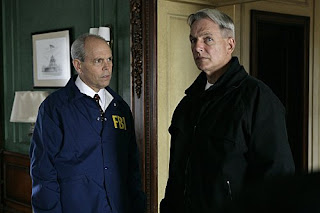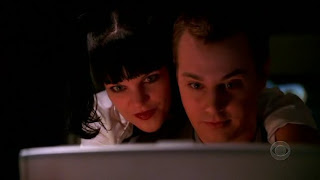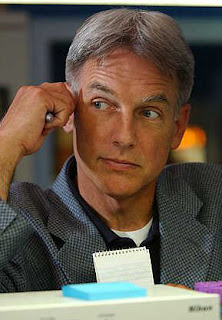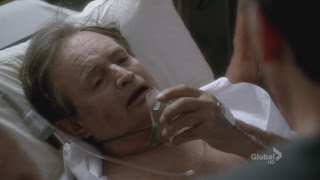(I planned on publishing this entry yesterday, before season 10 premiere, but couldn't)
NCIS debuted in 2003. It enters its 10th season tonight. It's ratings have steadily increased through its 9 years, and it's currently ranked among the top scripted shows on cable. But still, the show is rarely mentioned among "great shows", and is usually dismissed as "another procedural". Despite all that pedigree and its popularity among viewers, the show lacks the respect of other current shows.
The show follows a team within the real-life NCIS (Naval Criminal Investigative Service) dedicated to investigate major crimes against the Navy and Marines. The team is led by veteran Leroy Jethro Gibbs (Mark Harmon), and is comprised by a team of three Special Agents: Anthony DiNozzo (Michael Weatherly), Ziva David (Cote de Pablo), and Timothy McGee (Sean Murray). The team is completed by Forensic Specialist, Abby Sciuto (Pauley Perrette), Medical Examiner Donald "Ducky" Mallard (David McCallum), and his assistant, Jimmy Palmer (Brian Dietzen). Their job is overseen by NCIS Director, Leon Vance (Rocky Carroll).
So, what's the hook? I started watching the show by chance about 3 or 4 years ago. Flipping channels, nothing else to see. After one of those three-hour marathons, I was hooked. Ever since, I've been a loyal fan of the show, and have watched and rewatched every episode. So, to shed a little light in the aforementioned dilemma, here are the 10 rules that the writers of NCIS probably follow.
Rule #1: Keep the settings simple
NCIS takes place in what can be seen as a generic government building. The main bullpen is a sterile, tan-ish colored office room with little flash. The other settings inside the building (the autopsy room, the Director's office) are as generic and sterile as the bullpen. The notable exceptions could be MTAC (with its big screen) and Abby's laboratory. But the former's only standout feature is the huge screen, and the latter is more a result of Abby's colorful character.
The only other recurring setting featured prominently is Gibbs' house, which follows the same rule. In truth, Gibbs' house is as empty that it borders on "vacant" and "abandoned". There's not much else to see elsewhere. McGee's apartment was seen a couple of times in the first seasons, and so was Ziva's in the last seasons. To this day, DiNozzo's apartment has never been featured (I don't know if Jeanne ever visited him there, but it seemed they were always at her apartment).
This "rule" doesn't necessarily mean anything, but it does establish a precedent on the show of "no distractions". The setting is just that: a setting, and it shouldn't overshadow the characters that inhabit it. There are no flashy police stations, no luxurious houses, no shiny places. Just a normal building with normal offices. And after 9 years, the producers, writers, or directors have felt no need to "revamp" it or anything, which is fairly uncommon for shows nowadays, who feel the need to "revamp" their settings just to keep things "interesting". After the season 9 finale, we'll see how they deal with that.
Rule #2: Hire a dedicated cast
There are no huge stars in NCIS. Mark Harmon had a relatively decent career in the 80s/90s and David McCallum had his success in the 60s/70s, but that's about it. What it does have is a cast that's dedicated almost entirely to the show. Surprisingly enough, most of the cast's careers revolve around the show. Sean Murray hasn't done anything else in the last 9 years. Michael Weatherly has guest starred in 2-3 shows and 1 film in the last 9 years. Cote de Pablo has starred in only one film after joining the cast. And Pauley Perrette has guest starred in a handful of shows, but not much. Even Harmon has only appeared in a few films since the show began.
I don't know if their contracts limit their careers, but this is another instance of the same precedent as the above rule: "No distractions". The cast remains focused and dedicated to the show. There seem to be no external distractions with stars threatening to leave shows, or with disgruntled actors, and whatnot. And I suppose this keeps their minds and hearts on their characters, which in turn might instill the characters with more life than that of an actor that stars in more shows.
 |
| Joe Spano (Tobias Fornell) with Gibbs |
Rule #3: Find a solid supporting cast
Aside of the main cast, NCIS keeps a solid, recurring cast of supporting actors. Characters like Tobias Fornell, Mike Franks, Eli David, and Trent Kort, among others, have appeared in lots of episodes through the show. This deepens the connections between them and the main cast, and also helps establish a strong continuity from season to season.
Rule #4: Develop and encourage a strong chemistry between your cast
Other than finding the cast, the writers, directors, and the cast itself do a great job of developing a strong chemistry between the characters. Be it the paternal relationship between Gibbs/DiNozzo, or the brother-like banter of DiNozzo/McGee, or the romantic tension between DiNozzo/Ziva, or the innocent romance of McGee/Abby.
Even if none of the actors are particularly strong (at least when compared to other shows), they embody their characters, which makes you believe the relationships. Most of them don't feel forced, they feel natural. A similar example could be the lead cast of the original Star Wars trilogy, where none of them was particularly great, but they still had an excellent chemistry.
Rule #5: Keep the format simple...
Regardless of other considerations, NCIS is still, at its core, a procedural. Usually, every episode follows a separate case, and each episode follows a similar format: a body is found or a crime is committed, team investigates crime scene, they return to the bullpen where they come up with theories, suspects are interrogated, climax, crime is solved. This simple format makes the show easy to follow for casual viewers, like I was 3 or 4 years ago. I started watching random episodes, and still didn't find myself too lost. Sure, a lot of the character interactions are fleshed later, once you know what's going on, but the format is still a simple one. Again, "no distractions".
Rule #6: ...but without sacrificing the show's continuity
However, despite the show's procedural format, there are usually underlying subplots that are carried from season to season; and crucial seasonal subplots have their seeds planted sometimes since the beginning of the season, or before. For example, the motives of season 9 finale antagonist, Harper Dearing, have its seeds planted on the events of the season 9 premiere where we see other antagonists auctioning something Dearing wants. This events in turn come as a direct consequence of the events of the season 8 finale, which ended with the death of an NCIS agent and the extraction of the article to be auctioned later. And so on.
That dedication of the writers can be seen on almost every subplot. There's a certain care to the story that I haven't seen on other shows where plotpoints feel forced or rushed, or things don't flow as naturally. For example, the story of Gibbs' past (his wife and daughter) remains hidden until season 3, I think, but there are moments in the first seasons where you can see they hinted at it. Also, snippets of Gibbs and Jenny's past missions in Europe are scattered through the show at various points, and so are snippets of Vance's past.
There's a continuity, even with the little things. Like the use of DiNozzo's stapler, or calling McGee "Elf Lord", or Abby's hippo (Bert)... or with how they use pictures that were taken on previous episodes (like Ziva's bikini picture, or DiNozzo's "crazy" face). Also, past events are continuously referenced, like they would be on real life between co-workers that have spent 10 years together. Be it DiNozzo's illness, or McGee's book.All this attention to details help the viewers connect to the stories and help the natural flow of the show and its characters. It makes the characters feel more real.
 |
| Tony DiNozzo (Michael Weatherly) goofing off. |
Rule #7: Don't take the show too seriously
Even despite the seriousness of its subject, one of NCIS most notable traits is its humor. The writers and directors usually take a light approach to the subject, helped by the delivery and performance of the cast. The thing is that the humor usually doesn't feel forced. It just flows as a normal interaction between the characters. Be it Palmer's awkward interruptions, McGee's naivete, or DiNozzo's witty remarks. I think I've laughed more with some of the interactions between the characters than I have with some modern comedies.
However, this comedic aspect doesn't overshadow the necessary seriousness. The show knows when to take things more serious, and handles those shifts in its tone extremely well.
Rule #8: "Never date a coworker"
Just like Gibbs' rule #12 (Never date a coworker), the producers and writers seem to carry a similar rule. Don't let personal relationships overshadow the show and its format. For a show that begins its 10th year today, they've shown a lot of restraint in the way they handle the relationships between their characters. When other shows feel forced to stick unnecessary relationships for a character every season, this show has dangled potential ones for seasons, and when relationships are actually brought, there's a certain subtlety to it that doesn't allow them to take over the show.
 |
| Abby (Pauley Perrette) and McGee (Sean Murray) |
For example, McGee met Abby in season 1 and, although clearly smitten from the beginning, their relationship was nothing more than a passing comment on-screen. After their "break up", they've maintained an interesting relationship of mutual friendship, and even jealousy, but without it overtaking the show. Through those years, they both have had a few other relationships, but the possibility that they end up together again is still present. The other obvious example would be the relationship between Tony and Ziva, and writers have dangled that one since Ziva joined the team on season 3. Enter season 10 and still, nothing has happened. As a matter of fact, I kinda like that restraint.
Whenever relationships take center stage is because they are, sometimes unknown to us, central plotpoints. For example, the importance of Jeanne Benoit (Tony's girlfriend on season 4) was revealed later in the season when audience finds out she is the daughter of a powerful arms dealer, and that DiNozzo's relationship to her was merely a cover to capture her father. I also loved how they handled Gibbs' relationship with attorney Hart, where there was an ambiguity to it. Even his relationship with Jenny, which carries so much baggage, is underdeveloped. And that underdevelopment leads to his regrets later on.
Rule #9: Keep your characters growing
One of the strongest points of the show is how carefully they develop their characters. Like with all of the above, the writers and the cast take extreme care in not keeping the characters static. And if you've seen the show from the beginning, you'll see that the characters are the same, but they've just grown and changed with time. For example, DiNozzo's more mature than he was in season 1, McGee is more confident than he was in season 2, Ziva is more trustworthy than she was in season 3.
You can see interactions between McGee and Tony in season 1 and season 9, or Ziva and Gibbs in season 3 and season 9, and believe they're the same characters 8 or 9 years after. And you believe that change comes as a result of their experiences together. It was natural for McGee, who became an agent right after graduating, to feel a lack of confidence during the first seasons, which in turn makes him the butt of DiNozzo's jokes. But as the show goes on and he gains experience, he becomes more confident professionally and personally, and even develops a certain wit and healthy cockiness.
After you find out what Ziva has gone through and how she was raised, it was natural for her not to trust anyone. But as she spends more time with the team and starts disconnecting from her previous way of life, you can see how she opens up more to her partners and to Gibbs, whom she sees as an alternate paternal figure. Gibbs, in turn, sees her perhaps as the daughter she couldn't raise, and his relationship with her is notably different from his relationship with Tony, McGee, or even Kate.
Rule #10: Create a strong lead character
Finally, at the center of it all, lies the character of Leroy Jethro Gibbs. A character so carefully constructed by the writers and so neatly played by Mark Harmon, that it holds all the pieces of the show together. Sure, there is a cliché to him, but everything built upon that, is perfect. His story, his work ethic, his mannerisms. Harmon manages to infuse this character with such a rich performance, led mostly by his body language, that I can't see Harmon as anyone else. Like Kiefer Sutherland and Jack Bauer, Harmon has become Gibbs.
 |
| Leroy Jethro Gibbs (Mark Harmon) |
Gibbs is, as described by DiNozzo and others, a "functional mute". A guy so closed to everyone and withdrawn from everything. Someone who keeps his emotions bottled up and who chooses woodwork to vent his anger and frustrations, or to just relax. Harmon conveys so many things with his eyes, his face, or his body. Whether it's his sharp look when he expects his team to do something, or his exasperated sigh when things don't go the way he wants, or how cockily he handles suspects.
Gibbs is a bad-ass. But like with other things on the show, you believe he is such as a result of all his experience. It doesn't feel, at least for me, as Horatio Crane on CSI: Miami, with silly one-liners, sunglasses, and his coat in the wind. And as the show progresses, you can see he is vulnerable. We see his vulnerability in "Hiatus", where we find out about his past, or every time his wife and daughter are brought up. Heck, every time he interacts with kids, which bring out memories of the past, we see him struggle. Or in "Rule Fity-One", where he has to accept - at least to himself - that he can be wrong.
So, all in all, those are the main things why I love the show. Maybe my love for it blinds me from some of the weaknesses, but I still think it is an excellent show that deserves more respect. I acknowledge that a lot of other shows I'm watching are superior in lots of aspects (i.e.: Breaking Bad), but at the end of the day, NCIS feels like the one I love most.























+1.jpg)
